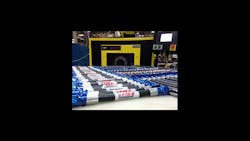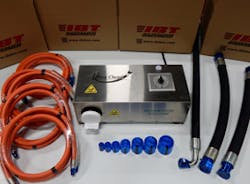Intensive Procedure Helps Ensure Hydraulic-Hose Cleanliness
- First, the hose is cut to meet a customer’s specifications.
- The IBT team then uses an Ultra-Clean hose cleaner that washes the inside of the hose three times to ensure less than 15 microns of contamination in the hose.
- A Goodyear PC650 system crimps the hose, recalibrating itself to the correct sizing and pressure for the specific product.
- IBT conducts a test to make sure that assemblies meet NAHAD/UL guidelines. All assemblies are tested with a 4:1 safety factor.
- Next, the ends of the hose are sealed and capped so that no contaminants can get in during shipping.
- Lastly, heat- and chemical-resistant self-vulcanizing labels , which display part number, system name, and test pressure, are applied to the hoses.
IBT is the only UL STAR-certified facility in its five-state region (Kansas, Missouri, Iowa, Oklahoma, and Arkansas). It exceeds all criteria for cleanliness and hose safety set by the National Association for Hose and Accessories Distribution (NAHAD), meeting guidelines for storage, temperature, hydraulic testing, cutting, and assembly methods. To ensure cleanliness of its products, the IBT facility undergoes UL inspections of equipment, processes, and workforce each year.
IBT also uses a Hose-Trakker software to track each hose produced in its facility. “At the customer’s request, we can follow any hose we produce, from cradle to grave,” said West. “When we cut the hose, we tag it and log it. Utilizing the Hose Trakker system, if your hose was assembled at IBT, we can now look up where it was made, the fittings used, the exact specifications, even when it was put into service—so that we can replicate it later.”
Source: Industrial Solutions PrimeMover Enewsletter
About the Author
Leah Scully
Associate Content Producer
Leah Scully is a graduate of The College of New Jersey. She has a BS degree in Biomedical Engineering with a mechanical specialization. Leah is responsible for Hydraulics & Pneumatics’ news items and product galleries.

Leaders relevant to this article:

